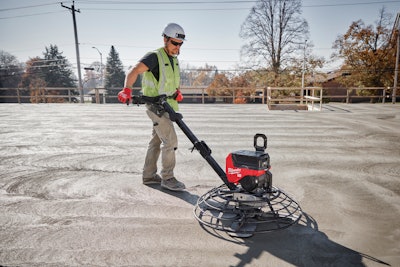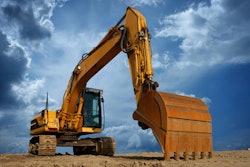
The list of hazards and hassles on the jobsite is, arguably, endless. Exposure to emissions, excessive noise, and slips, trips and falls continues to create potential health concerns for professionals in the construction trades. Pair the risks with the inconveniences and unreliability of the gas-powered equipment they use, their work becomes inefficient and cumbersome to do.
According to the 2021 Census of Fatal Occupational Injuries from the U.S. Bureau of Labor Statistics, a worker died every 101 minutes from a work-related injury. In 2021, there were 5,190 fatal work injuries recorded, an 8% increase from 2020. Battery-powered equipment can help to increase safety on the jobsite and reduce these statistics.
Not only are there added safety benefits to making the switch to battery-powered equipment, but there are also productivity enhancements to consider. Gas and cords can decrease efficiency on the jobsite. With no need to mix gas and oil and no regular maintenance needed, battery-powered equipment is more reliable, ultimately keeping crews productive.
Zero Emissions for a Safer Workplace
Enclosed work areas or confined spaces such as tunnels, basements, occupied spaces, or areas shelled off with plastic sheeting become hazardous when operating gas-powered equipment. Gas-powered tools produce high concentrations of carbon monoxide (CO), a poisonous, colorless, odorless, and tasteless gas. CO displaces oxygen in the blood and deprives the heart, brain, and other vital organs of oxygen when breathed in. Exposure to CO can overcome even the healthiest worker in a matter of minutes, causing illness, permanent neurological damage, and even death.
More and more frequently, concrete pours are needing to be done indoors or in areas not easily ventilated. Battery-powered equipment removes gas from the equation, keeping crews working safely and efficiently in enclosed spaces.
For example, trowels are used when finishing concrete for a smooth, flat surface. Commercial jobs in occupied buildings, such as hospitals, schools, and factories, often have strict no emissions rules that contractors need to follow. Residential basements and garages typically lack the ventilation needed to keep both the worker and client safe. If using a gas-powered trowel, a robust ventilation system would need to be set up, causing delays in the project and additional labor needs. Even a corded trowel may still require a gas-powered generator on site, and more labor is necessary to manage the cord while finishing the concrete. A battery-powered trowel produces zero emissions, reducing the risk of CO exposure and keeps the project progressing without the need to set up a ventilation system.
How Loud Is Too Loud?
Workplace noise is sometimes referred to as a “stealth, long-term hazard,” because hearing loss occurs slowly, in a painless, gradual process. High decibel levels may damage the cells and membranes in the inner ear. Repeated exposure will overwork those cells, which can cause them to die and result in hearing loss that surgery cannot fix. While hearing aids may help, they do not restore hearing back to normal.
When decibel levels are at or above 85 decibels (dB) over an average of eight working hours, the Occupational Safety and Health Administration’s (OSHA) Noise Standard requires employers to make hearing protection available to all employees and to implement a hearing conservation program. However, the equipment construction workers use daily is often above 85 dB. For example, a concrete saw can produce 100 dB and a hammer drill 120 dB.
The risk for noise-induced hearing loss is reduced with a decrease of even a few decibels. One method OSHA recommends to control decibel levels is to adjust engineering controls, such as modifying or replacing equipment, or making a physical change at either the source of the noise or along the path of noise transmission. This could be as simple as lubricating a squeaking bearing, or replacing a loud, gas-powered engine with a battery-powered solution.
A vibratory screed requires the operator and sometimes multiple scrapers to work within a few feet of the screed’s motor. The noise caused by the gas engine can be damaging to the worker’s hearing, and make communication while navigating the pad difficult. A battery-powered screed produces less noise, making it quieter than a gas engine. This helps reduce the noise exposure to the operator, scrapers, and the jobsite as a whole. It also helps improve communication among the crew, allowing them to talk over the noise better.
Eliminate Cords, Reduce Tripping Hazards
Cords are tripping hazards when run throughout the jobsite and can restrict the mobility of the operator. According to CPWR, the Center for Construction Research and Training, slips, trips, and falls are one of the leading causes of construction injuries, accounting for over 20,000 nonfatal and 300 fatal injuries annually since 2013. In 2020 alone, the construction industry accounted for just over 46% of all fatal slips, trips, and falls, according to the U.S. Bureau of Labor Statistics.
It’s not uncommon for the contractor to walk along the rebar or scaffolding with an electric concrete vibrator to consolidate the concrete in a column or wall. A corded concrete vibrator restricts the mobility of the operator, increasing the risk they lose their balance and footing. The extension cords running across the jobsite can create fall hazards for the other workers as well if not managed properly. Corded equipment increases the risk of tripping a breaker, delaying the crew to reset. A battery-powered concrete vibrator eliminates the need for extension cords entirely, reducing the chances for slips, trips, and falls, and preventing tripped breakers, ultimately reducing downtime on the jobsite.
Ditch the Hassles of Equipment Maintenance
Equipment is a large investment for a company and routine maintenance is one of the most important ways to protect that investment, minimize repair costs, and maximize profits. This can increase the cost of ownership over the lifetime of the product. Battery-powered equipment eliminates the need for maintenance caused by having a gas engine. With no wearable parts such as spark plugs, air filters, carburetors, and pull cords that need to be regularly maintained and managed, battery-powered equipment requires no gas, oil, or regular engine maintenance, giving users more confidence in their equipment. Priming, choking, and pulling a gas engine to start gas-powered equipment, such as a cut-off saw, is a lengthy and strenuous process, running the risk of flooding the engine and forcing the user to restart the process. Battery-powered solutions often provide instant power without the headaches associated with gas-powered equipment. Combined with the push-button start on the saw, the batteries eliminate the repetitive motions of a pull start and reduce downtime, allowing users to get jobs done faster. Additionally, gas-powered products require proper storage and transportation in order to ensure they work properly. Cut-off saws need to sit upright, keeping the gas where it is supposed to be. If accidentally tipped over in the back of the truck, for example, the gas can go in the wrong direction and flood through the system, damaging the saw.
The Future of the Jobsite
With new technological developments, there is a growing number of concrete equipment solutions that are battery-powered, and only more will continue to be seen across jobsites. Designed to take on the very same gas and corded equipment that the concrete industry has depended on, battery-powered equipment addresses the common hazards and frustrations. Today’s crews realize that the once-normalized risks can be addressed on the job site, decreasing safety concerns and keeping the equipment operators working efficiently.




















